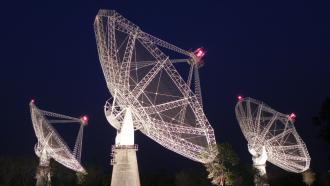
Photo: Kishalay De / Undergraduate Department, IISc
Indian astronomers have detected microstructure emissions from a millisecond pulsar for the first time. Millisecond pulsars (MSP) are highly magnetized, rapidly rotating neutron stars that take as little as one-thousandth to one-hundredth of a second to rotate about its axis once. In a recently published study, scientists from the Department of Physics at the Indian Institute of Science (IISc) and the National Centre for Radio Astrophysics (NCRA), Tata Institute for Fundamental Research (TIFR), have discovered these microstructure emissions using the Giant Metrewave Radio Telescope (GMRT), an array of thirty antennae scanning the sky for radio sources. They are now uncovering the processes that produce these microstructure emissions. While similar emissions had been discovered from more slowly rotating pulsars, this is the first time they have been discovered coming from millisecond pulsars.
“Pulsars rotate at the rate of about a few tens of rotations per second, and emit a beam of radiation along their magnetic axis. When this beam crosses the line of sight of an observer on Earth, this radiation can produce periodic pulses, pretty much like how a light house creates a periodic flash when viewed from a distance”, says Mr. Kishalay De, an undergraduate at the Department of Physics, IISc, at the time of the study. “If these neutron stars do not significantly interact with any other stars in their environment, they gradually slow down over time, giving rise to normal period pulsars, which typically have rotation periods of about a few tenths of a second to a few seconds. However, a significant fraction of these stars have nearby companion stars from which they gravitationally pull material onto their surface. As the material is pulled into the star, it spins up the rotating star, like a string pulling a spinning top, and gives rise to millisecond pulsars, which can rotate up to a few hundred times per second”, he adds.
While observing single pulses from normal period pulsars, researchers have long observed rapid periodic fluctuations within them, but did not understand their origin. Since the time scales of these fluctuations were of the order of about a few hundred microseconds, they came to be known as microstructures. But when scientists began looking for these microstructures in emission from MSPs, they did not find them, suggesting an absence of such structures within the pulses from a MSP, which could have important consequences for our understanding of microstructure emission.
For the current study, researchers made use of the high sensitivity of the Giant Meterwave Radio Telescope (GMRT), located near Pune, to radio waves with wavelength of about a metre. “The large collecting area of the telescope allows one to conduct very detailed studies of faint pulsars at low frequencies, which are otherwise impossible with almost all the other telescopes on Earth. Pulsars are also intrinsically brighter when viewed with low frequency radio waves, making the GMRT an ideal instrument for studying a variety of interesting phenomena in these sources”, remarks Mr De. The GMRT has been in operation since 2001. It is made of an array of thirty fully steerable, parabolic radio telescopes and can investigate a variety of radio sources like pulsars, neutron stars and other extragalactic radio sources.
Although the current study does not identify the mechanisms behind microstructure emissions, it puts constraints on the possible reasons for the existence of such microstructures. With the GMRT undergoing a major upgrade, scientists will be able to further probe the mysteries behind pulsar emissions in greater detail. “These features could potentially be produced by the fundamental emitting entities responsible for pulsar radio emission, or be manifestations of physical processes associated with them. Hence, it is very important to study these features in detail, to shed light on the still elusive pulsar emission mechanism”, concludes Mr. De.

























